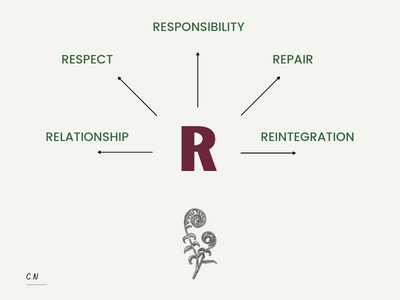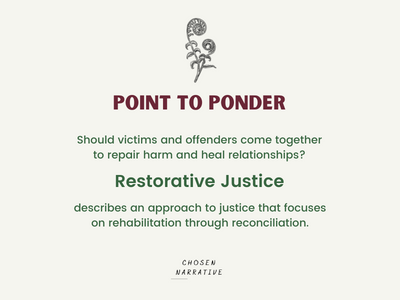
Restorative justice describes an approach to justice that strives to repair the harm caused by criminal activity. It allows different types of victims and perpetrators to communicate and address their needs in the aftermath of a crime.
Goals of Restorative Justice
If a case goes to court, Restorative Justice happens post-conviction and can occur while the perpetrator serves time in prison.
Restorative justice strives to achieve the following goals:
- Create a space for open communication between victims, offenders, and communities
- Encourage meaningful engagement and accountability
- Provide an opportunity for healing, reparation, and reintegration
- Reduce recidivism
- Produce greater satisfaction for victims
The essence of restorative justice can be summarized with these five principles:
- Relationship - strive to fix a damaged relationship
- Respect - respect is key to making relationships work
- Responsibility - everyone must take personal responsibility for their actions
- Repair - once respect and responsibility have been established, the element of repair slowly replaces thoughts of revenge and/or punishment
- Reintegration - encourages collaboration with the community and recognizes the benefits a person can bring to the table

Restorative justice is based on principles of respect, compassion, and inclusivity. It uses processes to achieve its goals, such as conferences and dialogues guided by skilled facilitators.
Restorative justice is a holistic approach to justice that addresses the needs of victims, including their material, financial, emotional, and social needs.
Does Restorative Justice Work?
The concept of restorative justice may sound productive, but the politics of restorative justice needs to be applied correctly (and carefully).
There are a few promising findings but little scientific evidence to prove that restorative justice works.
The majority of the programs have been implicated for juvenile offenders. While the results are mixed, there is good evidence that programs focused on minors contribute to reducing recidivism.
For example, one study revealed that 91% of victim participants participating in a restorative justice program in California were willing to participate in another conference. The same percentage would recommend the process to a friend.
In Winnipeg, an evaluation of a restorative justice program revealed that participating offenders had lower recidivism rates (15%) than the matched group of probationers (38%).
Communities for Restorative Justice have revealed more insights, showing that restorative justice programs have a more positive impact than traditional criminal justice.

There’s no denying that restorative justice is a heavy process that demands an open mind from both victims and offenders. There are instances when the program falls flat and others where major breakthroughs are achieved (for both parties).
Real-Life Examples of Restorative Justice
Statistics are useful in driving policy and systemic change, but it’s real-life human stories that change hearts.
Impacting the lives of (former) offenders
Restorative Justice Exchange is an initiative of the Prison Fellowship International which is committed to strengthening restorative practices in programs for prisoners, victims, and families of prisoners.
First, restorative justice changes the hearts and minds of those who have caused pain and anguish, inspiring them to change their lives for the better. One person involved in The Sycamore Tree program says the following.
Jose Fonseca, a former gangster in Columbia, served time for shooting a rival gang member. After serving time, he returned to the same neighborhoods to share his testimony and set an example for the youth. Restorative justice taught him about the ripple effect of his crimes — and he couldn’t shake the realization. He has even found peace with his victims.
Impacting the lives of victims
But it’s not only the former offenders that benefit from restorative justice. Consider Rob’s story, which has been shared by Why Me?
His son was robbed and attacked by three youths. One of the attackers was convicted to six months behind bars, and Rob was offered the opportunity for a restorative justice meeting. A year after the attack, the meeting took place, and Rob recalls his experience.
“After the attack, my son was clearly shaken and upset. I on the other hand was left with anger and no direction in which to channel it. I attended court but the process allowed no voice for the victim. Taking part in the Restorative Justice meeting was a chance to open up a conversation, in which both my son’s attacker and I could both listen and equally be heard. I anticipated that he would not answer the majority of my questions but he did listen to what I had to say about his senseless choice of actions on the evening he attacked my son.
I was also able to understand the young person’s background. Whilst not excusing his behavior that night, I did find myself having a certain amount of empathy and consideration for his circumstances which I was not expecting. At the end of the meeting I looked him in the eye, shook his hand and wished him all the best in his future. I hoped that with the benefit of him taking part in Restorative Justice from an offender’s perspective, he would think carefully about his future choices.
When I left the meeting, it felt like a weight had been lifted from me that I didn’t even realize I was carrying. I felt like my anger from the time of the attack had subsided but what I had unwittingly done was suppress it. Now finally after this meeting all the unwanted negativity I had held was finally and permanently gone.”


